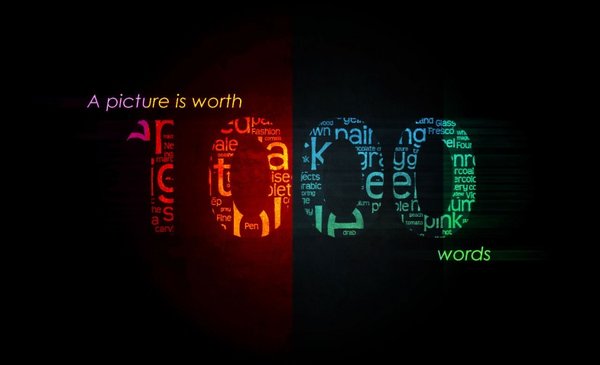
‘A picture is worth a thousand words.’ Cliché, but true. In fact, it’s a cliché because it’s true. A battle between pictures and words is like one between Mike Tyson and Tiny Tim: the picture throws the bigger punch. Consider the following:
- Two-thirds of all stimuli reaching the brain are visual (Zaltman, 1996).
- Over 50 per cent of the brain is devoted to processing visual images (Bates and Cleese, 2001).
- So 80 per cent of learning is visually based (American Optometric Association, 1991).
Marketers and brand owners, take note. Humans are extremely visual: we think largely in images, not words. What consumers and employees can’t actually see, or at the very least mentally envision, is most likely going to be lost on them. In ambiguous situations, most communication is non-verbal. Every day, we find ourselves in situations where the other party’s words and body language strike us as either opaque or conflicting. In those cases, what do we do? We rely more on non-verbal clues to evaluate the emotional state of the person speaking. Here are the exact statistics:
- 55 per cent of communication comes through facial expressions.
- 38 per cent of communication is through tone of voice.
- Only 7 per cent of communication is through verbal exchange.
For anyone who wants to ‘get back to basics’, remember that nothing is more basic than non-verbal communication. Human beings have existed for over 500,000 years, but we’ve had the benefit of language for less than a quarter of that time. Moreover, because the rational and sensory parts of the brain aren’t adjacent neighbors, we’re not very good at verbally describing the details our senses detect. Ironically, that’s true despite the fact that our gut-level perceptions are largely shaped by sensory impressions.
Emotions Color Perceptions And Inhibit Change
We perceive matters in ways that emotionally protect our habits and biases.
The processing of ‘facts’ is, in essence, as much about the processing of one’s emotions as it is the processing of whatever external dynamics a person happens to be experiencing.
For instance, how do we ‘choose’ which brands to notice? Well, the first step in the perceptual process is that of screening, which often occurs subconsciously. We tend to screen out the unfamiliar (since paying attention to unfamiliar stimuli requires effort). Instead, we prefer to focus on what we already know and can relate to more easily.
Yes, at times people will analyze the ‘facts’ vigorously, but emotions are more basic and more dominant. Remember: we feel before we think, and those reactions are subconscious, immediate and inescapable. That’s why our reactions are often hard to verbalize. Our language skills reside in the rational brain, which may not even get invoked, because automatic reactions are primarily emotional in nature. As the psychologist Robert Zajonc notes, to say ‘I decided in favor of X’ often means nothing more nor less than ‘I liked X’ – and that’s good enough.
Why is instinctive preference good enough? The reason is that emotional judgements tend to be irrevocable. In terms of our basic emotional reactions, we’re never wrong about what we like or dislike. Zajonc notes, the factual reality of ‘The cat is black’ pales in contrast to the more intimate emotional reality of ‘I don’t like black cats.’
What’s the last stage in the sequence of perception? It’s retrieval, which is mediated by our emotions yet again. We tend to store and recall more readily those experiences that fit most comfortably into our existing mental frameworks. Therefore, memory is driven by preferences rooted in being at ease with our choice. Consumers and employees alike often defend their choices or actions based on details they previously deemed rationally irrelevant. Why? The explanation is that emotions are self-justifying and, therefore, emotional reactions can become totally separated from content.
Therefore, remember that what we’ve already seen will predispose us to what we can see the next time around because of our emotional investment in what’s familiar to us. While a company may believe it has a technically or functionally superior offer, consumers’ evaluations are in essence emotionally based. Objectivity doesn’t exist, because everything gets filtered and colored by emotional responses. The bottom line is that there’s almost always more commercial gain to be made by going with, rather than against, what people have already emotionally internalized and accepted.
Contributed to Branding Strategy Insider by: Dan Hill, excerpted from his book, Emotionomics, with permission from Kogan Page publishing.
The Blake Project Can Help: Accelerate Brand Growth Through Powerful Emotional Connections
Branding Strategy Insider is a service of The Blake Project: A strategic brand consultancy specializing in Brand Research, Brand Strategy, Brand Licensing and Brand Education
FREE Publications And Resources For Marketers











